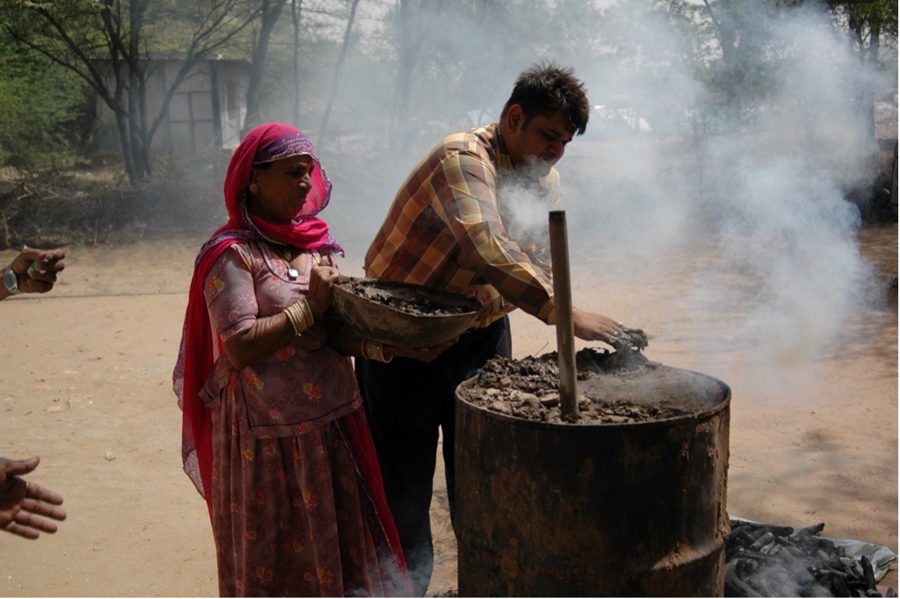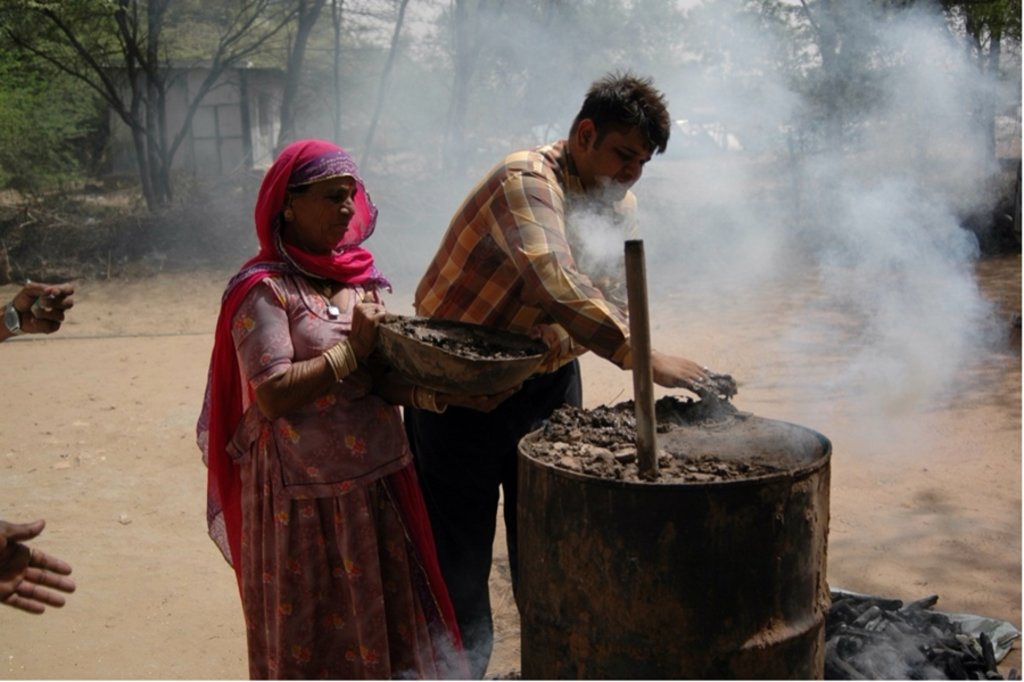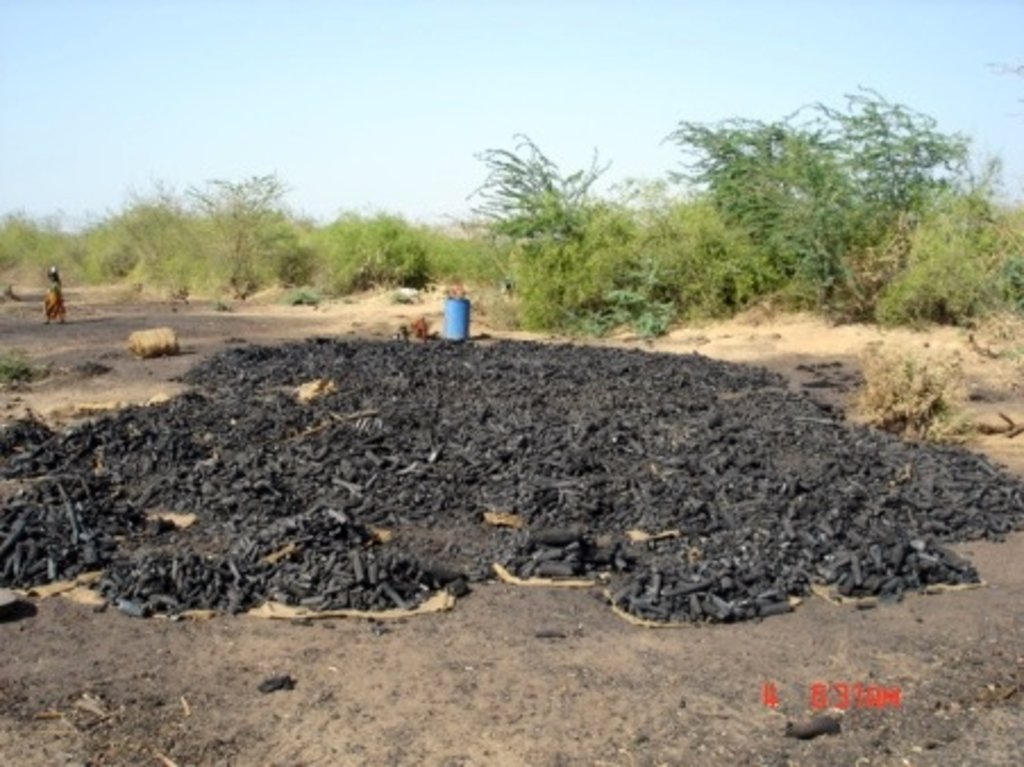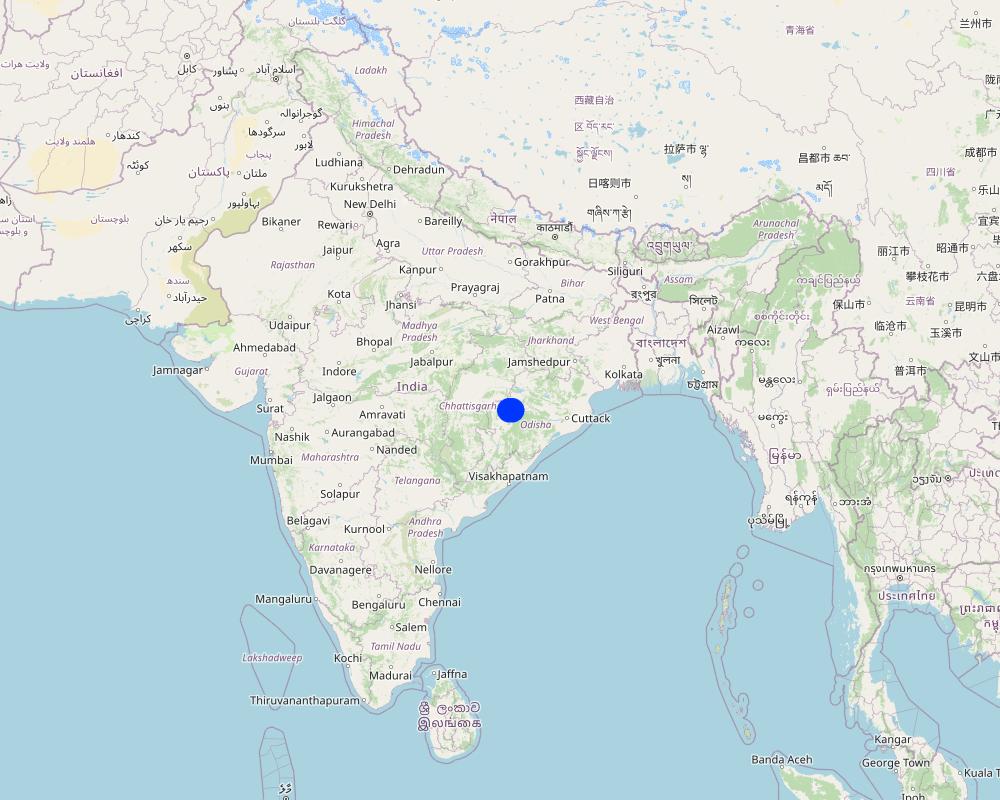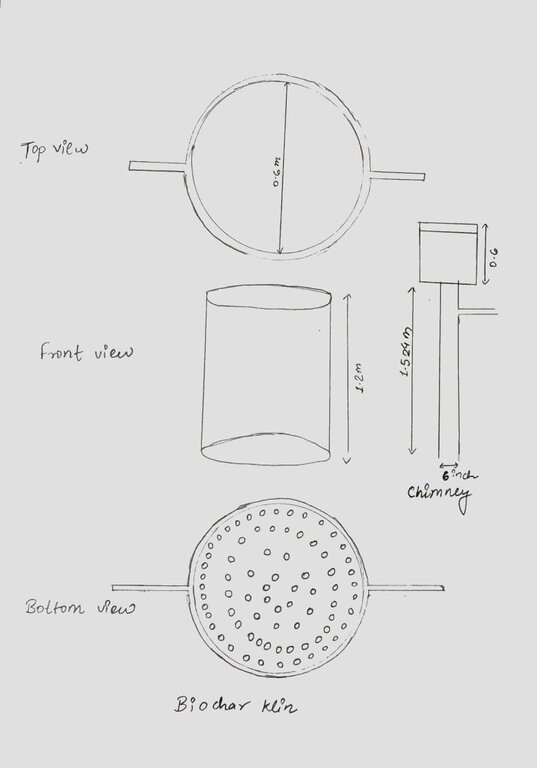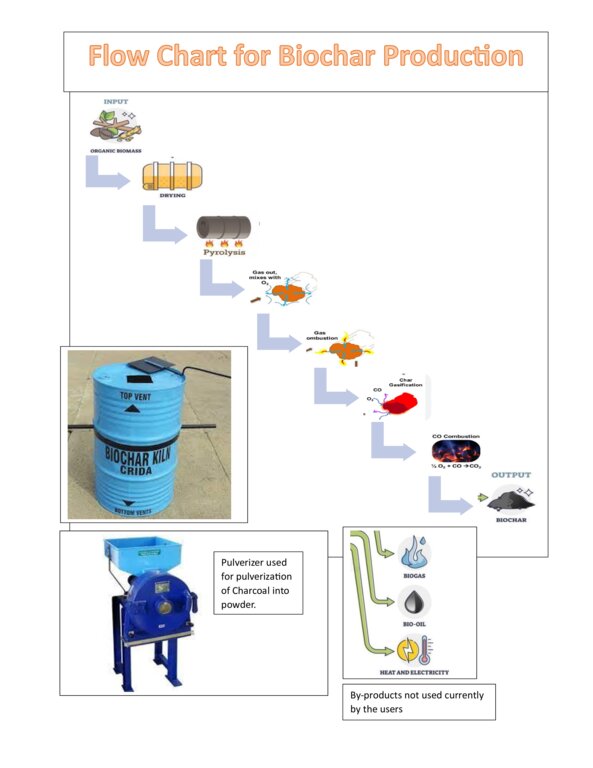Sustainable Biochar Production Through Agroforestry Systems And Its Application [ប្រទេសឥណ្ឌា]
- ការបង្កើត៖
- បច្ចុប្បន្នភាព
- អ្នកចងក្រង៖ Santosh Gupta
- អ្នកកែសម្រួល៖ Kim Arora, Stephanie Jaquet, Tabitha Nekesa, Ahmadou Gaye, Siagbé Golli
- អ្នកត្រួតពិនិត្យច្រើនទៀត៖ Udo Höggel, Sally Bunning
technologies_6735 - ប្រទេសឥណ្ឌា
ពិនិត្យមើលគ្រប់ផ្នែក
ពង្រីកមើលទាំងអស់ បង្រួមទាំងអស់1. ព័ត៌មានទូទៅ
1.2 ព័ត៌មានលម្អិតពីបុគ្គលសំខាន់ៗ និងស្ថាប័នដែលចូលរួមក្នុងការវាយតម្លៃ និងចងក្រងឯកសារនៃបច្ចេកទេស
ឈ្មោះគម្រោងដែលបានចងក្រងឯកសារ/ វាយតម្លៃលើបច្ចេកទេស (បើទាក់ទង)
Soil protection and rehabilitation for food security (ProSo(i)l)ឈ្មោះអង្គភាពមួយ (ច្រើន) ដែលបានចងក្រងឯកសារ/ វាយតម្លៃបច្ចេកទេស (បើទាក់ទង)
Deutsche Gesellschaft für Internationale Zusammenarbeit (GIZ) GmbH (GIZ) - ប្រទេសអាល្លឺម៉ង់ឈ្មោះអង្គភាពមួយ (ច្រើន) ដែលបានចងក្រងឯកសារ/ វាយតម្លៃបច្ចេកទេស (បើទាក់ទង)
International Centre for Research in Agroforestry (ICRAF) - ប្រទេសកេនយ៉ាឈ្មោះអង្គភាពមួយ (ច្រើន) ដែលបានចងក្រងឯកសារ/ វាយតម្លៃបច្ចេកទេស (បើទាក់ទង)
Ecociate Consultants (Ecociate Consultants) - ប្រទេសឥណ្ឌា1.3 លក្ខខណ្ឌទាក់ទងទៅនឹងការប្រើប្រាស់ទិន្នន័យដែលបានចងក្រងតាមរយៈ វ៉ូខេត
អ្នកចងក្រង និង(បុគ្គលសំខាន់ៗ)យល់ព្រមទទួលយកនូវលក្ខខណ្ឌនានាទាក់ទងទៅនឹងការប្រើប្រាស់ទិន្នន័យដែលបានចងក្រងតាមរយៈវ៉ូខេត:
បាទ/ចា៎
1.4 សេចក្តីប្រកាសស្តីពីចីរភាពនៃការពណ៌នាពីបច្ចេកទេស
តើបច្ចេកទេសដែលបានពណ៌នានេះមានបញ្ហាដែលផ្តោតលើការធ្លាក់ចុះគុណភាពដី, បើដូច្នេះវាមិនអាចត្រូវបានប្រកាសថាជាបច្ចេកទេសនៃការគ្រប់គ្រងប្រកបដោយចីរភាពទេ?
ទេ
មតិយោបល់:
The application of biochar to the soil is a technology that can prevent or reduce land degradation by improving soil health through the addition of organic matter, increase soil fertility and the water retention capacity of soils.
1.5 ការយោងទៅលើកម្រងបញ្ជីសំណួរ (មួយ ឬច្រើន) នៃវិធីសាស្ត្រផ្សព្វផ្សាយ SLM (ដែលបានចងក្រងដោយទស្សនៈពិភពលោកស្តីពីវិធីសាស្ត្រ និងបច្ចេកទេសងអភិរក្ស WOCAT)

Developing professional standards in the installation, maintenance and … [ប្រទេសម៉ាលី]
Ensure the sustainability of schemes and continuity of production, and reduce production costs
- អ្នកចងក្រង៖ Dieter Nill
2. ការពណ៌នាពីបច្ចេកទេស SLM
2.1 ការពណ៌នាដោយសង្ខេបពីបច្ចេកទេស
និយមន័យបច្ចេកទេស:
Biochar is a carbon-rich, solid material derived from a wide range of biomass or organic waste through a thermochemical method. It is an organic charcoal material that is the final product of pyrolysis, or high-temperature burning of agricultural biomass without oxygen. Surplus crop residues, agricultural waste, and wood from sustainable sources are used as feedstock (raw material). Such biochar production is linked with agroforestry plantation and agriculture to improve soil health and ensuring sustainable feedstock availability.
2.2 ការពណ៌នាលម្អិតពីបច្ចេកទេស
ការពណ៌នា:
Introduction and Background
Intensive cropping systems coupled with monocropping and high usage of synthetic fertilizers have led to the degradation of soils and depletion of nutrients directly affecting agricultural productivity and farmers' income. Farmers in the Balangir district of Odisha are facing similar challenges. To address these issues and promote sustainable farming practices, a biochar production initiative was introduced by utilizing crop residues and waste material from forests to produce biochar, a carbon-rich material that enhances soil fertility and soil structure. The initiative is a part of the Pro-Soil Project of Deutsche Gesellschaft für Internationale Zusammenarbeit (GIZ), India and implemented by the International Centre for Research in Agroforestry (ICRAF). The technology (a kiln for biochar production) and technical inputs for biochar production were sourced from the Indian Institute of Soil Science, Bhopal.
Biochar is a type of charcoal produced from biomass like agricultural or forest waste or organic materials through a process called pyrolysis. The application of sustainable biochar technology in agroforestry systems can lead to better soil structure, increased water retention, reduced nutrient leaching, and improved crop yields. Moreover, it aids in mitigating greenhouse gas emissions by locking carbon into soil for an extended period.
In the project region farmers used crop residues such as rice straw, wheat straw and residue of other crops along with non-usable biomass from local forests, such as branches, twigs, and leaves, to supplement the feedstock for the pyrolysis. Since the District has large forest areas, the availability of forest waste is no problem. The biochar produced was applied into existing crops fields as well as into agroforestry system. Aiming to promote agroforestry, the project promoted the integration of trees (both fruits and timber) and shrubs into existing agricultural practices. Agroforestry offers multiple benefits such as improved soil health, biodiversity, and carbon sequestration. When sustainable biochar production is integrated into these systems, it can create a sustainable cycle where agricultural waste is converted into biochar, which then enhances soil fertility and sequesters carbon when added back into the soil.
The project has actively involved women farmers, entrepreneurial youth, and farmers' groups in the collection, production and application process of biochar thus promoting community participation and creating awareness about the benefits of biochar.
Implementation
The biochar kiln technology, obtained from the Indian Institute of Soil Science, in Bhopal, is employed to convert biomass into biochar through pyrolysis. This technology ensures efficient and controlled production of high-quality biochar. The collected biomass undergoes a controlled pyrolysis process inside the biochar kiln, where it is burned in the relative absence of oxygen. Technical specialization during production includes kiln temperature control, feedstock preparation, and the management of pyrolysis gases to ensure efficient biochar production. This results in the conversion of biomass into biochar, also leaving behind bioenergy-rich gases. Quality control measures are implemented to ensure the production of biochar with optimal characteristics, including high carbon content, porosity, and stability.
The Biochar kiln used was designed with the aim to optimize temperature control and ensure efficient conversion of biomass. An efficient loading mechanism allows easy and controlled feeding of biomass into the kiln. This ensures a consistent flow of material during the pyrolysis process. Although local kilns are usually not equipped with temperature control mechanisms to regulate the pyrolysis temperature, the temperature in the kilns may alternatively be regulated through the rate of feeding biomass into the kilns. Such kilns usually have some safety features and proper ventilation so to prevent accidents.
To implement this technology the ICRAF conducted training sessions for farmers on the proper preparation and application of biochar. The trainings were focused on the following aspects:
-The collection and drying process for agriculture and forest waste
-The management of operations for the biochar kiln including the loading of raw material (feedstock) into the kiln, its burning, operation-timing, period check, volumes of raw material to be fed etc.
-Precautions to be taken during the process
-The quality check of prepared biochar charcoal and the process for pulverizing it
-Dosage recommendations for different crops as per local conditions
-The mixing of biochar with cow dung and cow urine before application
-Integration with existing farming practices and the long-term benefits of biochar on soil health
Impact and Knowledge Transfer
The biochar acts as a soil conditioner, enhancing water retention, nutrient availability, and microbial activity. The benefits and impacts on improved fertility, increased water retention, and reduced nutrient leaching, lead to higher crop yields and resilience against climate variability, carbon sequestration aids in reducing greenhouse gas emissions, contributing to global efforts to combat climate change, and utilizing agricultural residues reduces air pollution from open burning and provides a sustainable solution for organic waste disposal. Land users appreciated the enhanced soil productivity and environmental benefits brought by biochar. Overall, the Sustainable Biochar Production Technology represents a promising approach in sustainable agriculture and environmental stewardship.
The project team, in collaboration with local agricultural extension services and the Indian Institute of Soil Science, monitored the impact of biochar application on soil health parameters. This involved regular soil testing, crop yield assessments and feedback from participating farmers. In fact, they also measured the impact of biochar made from different feedstock (raw materials). Success stories were shared with neighboring communities, public stakeholders and researchers and encouraged the further adoption of sustainable soil management practices.
The biochar production initiative in the Balangir District of Odisha in India demonstrates a sustainable approach to addressing soil health issues using locally available resources. Through the collaboration between ICRAF and GIZ, this project not only improves soil fertility but also empowers local communities by providing them with sustainable solutions for agricultural challenges. The success of this intervention serves as a model for future initiatives aimed at promoting environmentally friendly and community-driven approaches to agriculture.
2.3 រូបភាពនៃបច្ចេកទេស
2.4 វីដេអូនៃបច្ចេកទេស
ការពណ៌នាសង្ខេប:
https://www.youtube.com/watch?v=qHpIPVX2mR8&t=8s
ទីតាំង:
Bhopal, MP
ឈ្មោះអ្នកថតវីឌីអូ:
ICAR-CIAE
2.5 ប្រទេស/តំបន់/ទីតាំងកន្លែង ដែលបច្ចេកទេសត្រូវបានអនុវត្ត និងបានគ្រប់ដណ្តប់ដោយការវាយតម្លៃនេះ
ប្រទេស:
ប្រទេសឥណ្ឌា
តំបន់/រដ្ឋ/ខេត្ត:
Odisha
បញ្ជាក់ពីការសាយភាយនៃបច្ចេកទេស:
- អនុវត្តនៅកន្លែងជាក់លាក់មួយ/ ប្រមូលផ្តុំនៅតំបន់តូចៗ
តើបច្ចេកទេស (មួយ ឬច្រើន) ទាំងនោះស្ថិតនៅក្នុងតំបន់ការពារជាអចិន្ត្រៃយ៍ណាមួយដែរឬទេ?
ទេ
Map
×2.6 កាលបរិច្ឆេទនៃការអនុវត្ត
បង្ហាញឆ្នាំនៃការចុះអនុវត្ត:
2021
2.7 ការណែនាំពីបច្ចេកទេស
សូមបញ្ជាក់តើបច្ចេកទេសត្រូវបានណែនាំឱ្យអនុវត្តដោយរបៀបណា:
- ពេលកំពុងពិសោធន៍
- តាមរយៈគម្រោង / អន្តរាគមន៍ពីខាងក្រៅ
មតិយោបល់ (ប្រភេទនៃគម្រោង ។ល។):
Piloting best practices to produce biochar using diverse feedstock and its application
3. ចំណាត់ថ្នាក់នៃបច្ចេកទេស SLM
3.1 គោលបំណងចម្បង (១ ឬច្រើន) នៃបច្ចេកទេសនេះ
- ធ្វើឱ្យប្រសើរឡើងនូវផលិតកម្ម
- កាត់បន្ថយ, បង្ការ, ស្តារឡើងវិញនូវការធ្លាក់ចុះគុណភាពដី
- អភិរក្សប្រព័ន្ធអេកូឡូស៊ី
- អភិរក្ស/ធ្វើឱ្យប្រសើរឡើងជីវចម្រុះ
- បន្ស៊ាំទៅនឹងការប្រែប្រួលអាកាសធាតុ/គ្រោះមហន្តរាយ និងផលប៉ះពាល់របស់វា
- បង្កើតផលប្រយោជន៍សេដ្ឋកិច្ច
3.2 ប្រភេទដីប្រើប្រាស់មួយប្រភេទ (ច្រើនប្រភេទ) ដែលបានអនុវត្តបច្ចេកទេស
ដីប្រើប្រាស់ចម្រុះនៅលើដីតែមួយ:
ទេ

ដីដាំដំណាំ
- ដំណាំប្រចាំឆ្នាំ
- ប្រភេទដើមឈើធំៗ និងដើមឈើតូចៗ
ដំណាំប្រចាំឆ្នាំ - បញ្ជាក់ប្រភេទដំណាំ:
- ធញ្ញជាតិ - ពោតសាលី
- ធញ្ញជាតិ - ស្រូវ (តំបន់ខ្ពង់រាប)
ប្រភេទដើមឈើធំៗ និងដើមឈើតូចៗ - បញ្ជាក់ប្រភេទ:
- ដំណាំចំណី (Calliandra, Leucaena leucocephala, Prosopis, etc.)
- ផ្លែឈើផ្សេងៗ
ចំនួនសារដែលដាំដំណាំក្នុងមួយឆ្នាំ:
- 2
សូមបញ្ជាក់:
Mostly farmers are cultivating during the monsoon season as these are the rainfed farmers. Some farmers with irrigation facilities are cultivating in winter season as well
តើជាការអនុវត្តន៍ដំណាំចន្លោះ?
បាទ/ចា៎
ប្រសិនបើបាទ/ច៎ា សូមបញ្ជាក់ប្រភេទដំណាំដែលដាំចន្លោះគ្នានោះ:
Millets and other cereals
តើជាការអនុវត្តន៍ដំណាំវិលជុំ?
បាទ/ចា៎
បើបាទ/ច៎ា សូមបញ្ជាក់:
Cereals, Pulses, Fodder crops

ដីព្រៃ/ដីដាំដើមឈើ
- ព្រៃ (ពាក់កណ្តាល) ធម្មជាតិ/ ដីព្រៃ
ព្រៃ (ពាក់កណ្តាល) ធម្មជាតិ / ដីព្រៃ៖ បញ្ជាក់ប្រភេទនៃការគ្រប់គ្រង:
- ឈើងាប់ៗ/ មែកដែលបាក់
តើប្រភេទឈើខាងលើជាប្រភេទឈើក្នុងព្រៃល្បោះ ឬស្រោង?
- ព្រៃល្បោះចម្រុះ/ ព្រៃស្រោង
ផលិតផល និងសេវាកម្ម:
- ឈើហ៊ុប
- អុស
- ផ្លែឈើ និងគ្រាប់ធញ្ញជាតិ
- វាលស្មៅ

លំនៅដ្ឋាន ហេដ្ឋារចនាសម្ព័ន្ធ
- ដីលំនៅស្ថាន អគារ
3.3 បន្ទាប់ពីអនុវត្តបច្ចេកទេស តើដីប្រើប្រាស់មានការប្រែប្រួលដែររឺទេ?
បន្ទាប់ពីអនុវត្តបច្ចេកទេស តើដីប្រើប្រាស់មានការប្រែប្រួលដែររឺទេ?
- ទេ (បន្តទៅសំណួរ 3.4)
3.4 ការផ្គត់ផ្គង់ទឹក
ការផ្គត់ផ្គង់ទឹកនៅកន្លែងអនុវត្តបច្ចេកទេស:
- ទឹកភ្លៀង និងប្រព័ន្ធស្រោចស្រព
មតិយោបល់:
Most farmers are cultivating in rainfed conditions while some also have irrigation facilities
3.5 ក្រុម SLM ដែលបច្ចេកទេសស្ថិតនៅក្នុង
- ធ្វើឱ្យប្រសើរឡើងគម្របដី/ ដំណាំគម្របដី
- ការស្តុកទុកទឹក
- ការគ្រប់គ្រងកាកសំណល់/ ការគ្រប់គ្រងទឹកកង្វក់
3.6 វិធានការ SLM ដែលបញ្ចូលនូវបច្ចេកទេស

វិធានការក្សេត្រសាស្ត្រ
- A1: ដំណាំ/គម្របដី
- A2: សារធាតុសរីរាង្គ/ជីជាតិដី
- A3: ការរក្សាស្រទាប់ដីខាងលើ
- A6: ការគ្រប់គ្រងកាកសំណល់

វិធានការរុក្ខជាតិ
- V4: ការជំនួស ឬការយកចេញនៃប្រភេទរុក្ខជាតិក្រៅស្រុក/ ការរាតត្បាត
- V5: ផ្សេងៗ

វិធានការគ្រប់គ្រង
- M6: ការគ្រប់គ្រងសំណល់ (កែឆ្នៃទ្បើងវិញ ប្រើប្រាស់ឡើងវិញ ឬបន្ថយការប្រើប្រាស់)

វិធានការផ្សេងៗ
សូមបញ្ជាក់:
Climate resilient soil management by application of biochar using varied feedstock (rwa material) generated through agroforestry
3.7 កំណត់ប្រភេទនៃការធ្លាក់ចុះគុណភាពដីសំខាន់ៗដែលបច្ចេកទេសនេះបានដោះស្រាយ

ការហូរច្រោះដីដោយសារទឹក
- Wt: ការបាត់ដីស្រទាប់លើដោយការហូរច្រោះ

ការបាត់បង់រូបសាស្ត្រនៃដី
- Ps: ការស្រុតចុះនូវសារធាតុសរីរាង្គនៃដី ការពន្លិចដី

ការធ្លាក់ចុះជីវសាស្ត្រនៃដី
- Bl: ការបាត់បង់មីក្រូ និងម៉ាក្រូសរីរាង្គរបស់ដី
3.8 ការពារ កាត់បន្ថយ ឬស្តារឡើងវិញនៃការធ្លាក់ចុះគុណភាពដី
បញ្ជាក់ពីគោលដៅរបស់បច្ចេកទេស ដែលផ្តោតទៅការធ្លាក់ចុះគុណភាពដី:
- ការកាត់បន្ថយការធ្លាក់ចុះគុណភាពដី
- ការជួសជុល/ ស្តារឡើងវិញនៃឱនភាពដីធ្ងន់ធ្ងរ
4. បច្ចេកទេសជាក់លាក់ សកម្មភាពអនុវត្ត ធាតុចូល និងថ្លៃដើម
4.1 គំនូសបច្ចេកទេសនៃបច្ចេកទេសនេះ
លក្ខណៈពិសេសនៃបច្ចេកទេស (ទាក់ទងនឺងគំនូរបច្ចេកទេស):
The single barrel biochar klin was developed by the Indian Institute of Soil Sciences in Bhopal (IISS). The Kiln had already been designed and commercialised by the IISS. Land users can buy a metallic kiln unit from the IISS or get it fabricated from local fabricators based on the design specifications suggested in the drawing.
ឈ្មោះអ្នកនិពន្ធ:
Payal Dewangan
កាលបរិច្ឆេទ:
12/07/2023
លក្ខណៈពិសេសនៃបច្ចេកទេស (ទាក់ទងនឺងគំនូរបច្ចេកទេស):
The flowchart provides a step by step guide for biochar production in the project area by land users
ឈ្មោះអ្នកនិពន្ធ:
Payal and Santosh
កាលបរិច្ឆេទ:
20/11/2023
4.2 ព័ត៌មានទូទៅដែលពាក់ព័ន្ធនឹងការគណនាធាតុចូល និងថ្លៃដើម
កំណត់របៀបនៃការគណនាថ្លៃដើម និងធាតុចូល:
- ក្នុងឯកតាបច្ចេកទេស
បញ្ជាក់ឯកតា:
200 L capacity
បញ្ជាក់ពីទំហំនៃឯកតា (បើពាក់ព័ន្ធ):
Litre
ផ្សេងៗ/ រូបិយប័ណ្ណជាតិ (បញ្ជាក់):
INR
បើពាក់ព័ន្ធសូមកំណត់អត្រាប្តូរប្រាក់ពីដុល្លាទៅរូបិយប័ណ្ណតំបន់ (ឧ. 1 ដុល្លារ = 79.9 រៀលនៃរូបិយប័ណ្ណប្រេស៊ីល) ៖ 1 ដុល្លារ =:
80,0
កំណត់ថ្លៃឈ្នួលជាមធ្យមនៃការជួលកម្លាំងពលកម្មក្នុងមួយថ្ងៃ:
204 Rupees
4.3 សកម្មភាពបង្កើត
| សកម្មភាព | រយៈពេល (រដូវកាល) | |
|---|---|---|
| 1. | Purchase of biochar kiln unit | Can be done any time during the year but need to be ready before the month of September |
| 2. | Purchase of pulveriser | Need to be purchased once and before the start of biochar production |
មតិយោបល់:
Both biochar kiln and pulveriser are fixed investments and can last up to 5 years
4.4 ថ្លៃដើម និងធាតុចូលដែលត្រូវការសម្រាប់ការបង្កើតបច្ចេកទេស
| បញ្ជាក់ពីធាតុចូល | ឯកតា | បរិមាណ | ថ្លៃដើមក្នុងមួយឯកតា | ថ្លៃធាតុចូលសរុប | % នៃថ្លៃដើមដែលចំណាយដោយអ្នកប្រើប្រាស់ដី | |
|---|---|---|---|---|---|---|
| សម្ភារៈ | Biochar Klin | Rs. | 1,0 | 7000,0 | 7000,0 | |
| សម្ភារៈ | Pulvariser unit | Rs. | 1,0 | 20000,0 | 20000,0 | |
| ថ្លៃដើមសរុបក្នុងការបង្កើតបច្ចេកទេស | 27000,0 | |||||
| ថ្លៃដើមសរុបក្នុងការបង្កើតបច្ចេកទេសគិតជាដុល្លារ | 337,5 | |||||
ប្រសិនបើអ្នកប្រើប្រាស់ដីមិនមានថ្លៃដើម 100% សូមបញ្ជាក់ថានរណាដែលចំណាយថ្លៃដើមដែលនៅសល់:
The project paid towards the fixed investment costs of biochar kiln and pulverizier unit
4.5 សកម្មភាពថែទាំ
| សកម្មភាព | ពេលវេលា/ ភាពញឹកញាប់ | |
|---|---|---|
| 1. | Collecting the crop residues and forest waste | Needs to be collected and dried before the start of biochar production unit (September and June) |
| 2. | Preparation of Biochar | Before the sowing of Rabi (winter) and Kharif (summer) seasons (Months of September/October and June/July) |
| 3. | Application of biochar in the field | During the cropping season |
មតិយោបល់:
These activities may vary based on the cropping pattern and farmers' need of biochar application
4.6 កំណត់ថ្លៃដើមសម្រាប់ការថែទាំ/ សកម្មភាពរបស់បច្ចេកទេស (ក្នុងរយៈពេលមួយឆ្នាំ)
| បញ្ជាក់ពីធាតុចូល | ឯកតា | បរិមាណ | ថ្លៃដើមក្នុងមួយឯកតា | ថ្លៃធាតុចូលសរុប | % នៃថ្លៃដើមដែលចំណាយដោយអ្នកប្រើប្រាស់ដី | |
|---|---|---|---|---|---|---|
| កម្លាំងពលកម្ម | Preparation of biochar | Person-day | 2,0 | 200,0 | 400,0 | 100,0 |
| កម្លាំងពលកម្ម | Application of biochar in the field | Person-day | 1,0 | 200,0 | 200,0 | 100,0 |
| ជី និងសារធាតុពុល | Farmyard manure | Rs. | 20,0 | 5,0 | 100,0 | 100,0 |
| ជី និងសារធាតុពុល | Fertilizer | Rs. | 50,0 | 7,0 | 350,0 | 100,0 |
| ថ្លៃដើមសរុបសម្រាប់ការថែទាំដំណាំតាមបច្ចេកទេស | 1050,0 | |||||
| ថ្លៃដើមសរុបសម្រាប់ការថែទាំដំណាំតាមបច្ចេកទេសគិតជាដុល្លារ | 13,13 | |||||
មតិយោបល់:
The application of biochar was practiced by land users twice in a year, before sowing kharif and rabi crops. The amount of maintenance activities of the technology is count double for a year as farmers are practicing the biochar technology for two seasons in a year.
4.7 កត្តាសំខាន់បំផុតដែលមានឥទ្ធិពលដល់ការចំណាយ
ពណ៌នាពីកត្តាប៉ះពាល់ចម្បងៗទៅលើថ្លៃដើម:
The investment towards the purchase of the kiln- and the pulveriser unit. In the documented project, the investment costs were borne by the project. Therefore, smallholder farmers may find it difficult to purchase the hardware units of kiln and pulveriser, given such investment costs.
5. លក្ខណៈបរិស្ថានធម្មជាតិ និងមនុស្ស
5.1 អាកាសធាតុ
បរិមាណទឹកភ្លៀងប្រចាំឆ្នាំ
- < 250 មម
- 251-500 មម
- 501-750 មម
- 751-1,000 មម
- 1,001-1,500 មម
- 1,501-2,000 មម
- 2,001-3,000 មម
- 3,001-4,000 មម
- > 4,000 មម
កំណត់បរិមាណទឹកភ្លៀង (បើដឹង) ជា មីលីម៉ែត្រ:
1288,00
បញ្ជាក់ឈ្មោះឯកសារយោងនៃស្ថានីយឧតុនិយម:
Bhubaneshwar, Odisha
តំបន់កសិអាកាសធាតុ
- មានភ្លៀងមធ្យម
The District is located under the West Central Table Land Agro Climatic Zone characterized by hot and sub-humid climate
5.2 សណ្ឋានដី
ជម្រាលជាមធ្យម:
- រាបស្មើ (0-2%)
- ជម្រាលតិចតួច (3-5%)
- មធ្យម (6-10%)
- ជម្រាលខ្ពស់បន្តិច (11-15%)
- ទីទួល (16-30%)
- ទីទួលចោត (31-60%)
- ទីទួលចោតខ្លាំង (>60%)
ទម្រង់ដី:
- ខ្ពង់រាប
- កំពូលភ្នំ
- ជម្រាលភ្នំ
- ជម្រាលទួល
- ជម្រាលជើងភ្នំ
- បាតជ្រលងភ្នំ
តំបន់តាមរយៈកម្ពស់ :
- 0-100 ម
- 101-500 ម
- 501-1,000 ម
- 1,001-1,500 ម
- 1,501-2,000 ម
- 2,001-2,500 ម
- 2,501-3,000 ម
- 3,001-4,000 ម
- > 4,000 ម
បញ្ជាក់ថាតើបច្ចេកទេសនេះត្រូវបានអនុវត្តន៍នៅក្នុង:
- មិនពាក់ព័ន្ធទាំងអស់
មតិយោបល់ និងបញ្ចាក់បន្ថែមអំពីសណ្ឋានដី :
Balangir District is divided into four Agro-Ecological situations (AES) and characterized by a hot dry summer and highly erratic rainfall distribution of south-west monsoon rains, i.e., (i) plain land irrigated, (ii) plain land rainfed (iii) undulating plain drought-prone and (iv) undulating sub-mountainous tract rainfed.
The altitude of the Bolangir district is 207 masl.
5.3 ដី
ជម្រៅដីជាមធ្យម:
- រាក់ខ្លាំង (0-20 សម)
- រាក់ (21-50 សម)
- មធ្យម (51-80 សម)
- ជ្រៅ (81-120 សម)
- ជ្រៅខ្លាំង (> 120 សម)
វាយនភាពដី (ស្រទាប់លើ):
- គ្រើម/ មានពន្លឺ (ខ្សាច់)
- ម៉ត់/ ធ្ងន់ (ឥដ្ឋ)
វាយនភាពដី (> 20 សម ស្រទាប់ក្នុង):
- គ្រើម/ មានពន្លឺ (ខ្សាច់)
- ម៉ត់/ ធ្ងន់ (ឥដ្ឋ)
សារធាតុសរីរាង្គនៅស្រទាប់ដីខាងលើ:
- ទាប (<1%)
បើអាចសូមភ្ជាប់ការពណ៌នាពីដីឱ្យបានច្បាស់ ឬព័ត៌មានដែលអាចទទួលបាន ឧ. ប្រភេទដី, pH ដី/ ជាតិអាស៊ីត, សមត្ថភាពផ្លាស់ប្តូរកាចុង, វត្តមាននីត្រូសែន, ភាពប្រៃ ។ល។:
Mixed red and yellow soils occur as catenary associations in undulating and rolling terrains which differ in depth, texture, and color. Red and yellow soils are moderately shallow in depth and coarse-textured. Upland soils are shallower and lighter in texture than low-land soils.
Red and black soils are light to medium textured having neutral pH. These soils occur in mixed forms of both red & black soil together in which black soils occur in patches within the predominant red soils.
Black soils are mostly found in Puintala Block and in some parts of Loisingha Block. The soils are heavier in texture having clay content more than 30%. Clay minerals are predominant with smectites due to which deep cracks are seen to develop during summer.
Laterite soils are generally distributed in a few limited patches in the Balangir District. These soils are loamy sand to sandy loam in the surface having a hard clay pan in the subsoil. Crusting is a problem in upland literite.
Brown forest soils are mostly found in Khaprakhol, Tureikela, Bangomunda, Titilagarh, Saintala, and Gudvella Block. These soils are brown to grey-brown in color, light textured, and acidic in reaction.
5.4 ទឹកដែលអាចទាញមកប្រើប្រាស់បាន និងគុណភាពទឹក
នីវ៉ូទឹកក្រោមដី:
5-50 ម
ទឹកលើដីដែលអាចទាញយកប្រើប្រាស់បាន:
ល្អ
គុណភាពទឹក (មិនបានធ្វើប្រត្តិកម្ម):
ទឹកពិសារដែលគ្មានគុណភាព (តម្រូវឱ្យមានការសំអាត)
គុណភាពទឹក គឺផ្តោតទៅលើ៖:
ទាំងទឹកក្រោមដី និងលើផ្ទៃដី
តើមានបញ្ហាភាពទឹកប្រៃហូរចូលមកដែរឬទេ?
បាទ/ចា៎
សូមបញ្ជាក់:
Balangir District falls within the Western Plateau and Hills Zone of Odisha, characterized by a semi-arid climate. The agro-climatic conditions include hot summers, limited rainfall, and erratic monsoons, which pose challenges for agriculture due to water scarcity. In many regions of Odisha, including Balangir, water salinity is a significant concern, especially in areas relying on groundwater sources.
តើទឹកជំនន់កំពុងកើតមាននៅតំបន់នេះដែររឺទេ?
ទេ
មតិយោបល់ និងលក្ខណៈពិសេសផ្សេងៗទៀតលើគុណភាព និងបរិមាណទឹក :
The groundwater level at 3 meters below ground level in 2019 indicates water table that lies within 3-5 meters below ground level (m bgl) or less is considered shallow. This level often indicates good accessibility to groundwater, making it relatively easier for extraction using shallow wells or hand pumps.
5.5 ជីវៈចម្រុះ
ភាពសម្បូរបែបនៃប្រភេទ:
- ខ្ពស់
ភាពសម្បូរបែបនៃទីជម្រក:
- ខ្ពស់
មតិយោបល់ និងលក្ខណៈពិសេសផ្សេងទៀតលើជីវចម្រុះ:
The Odisha Government has declared the Gandhamardan Hill Range in Bargarh and Balangir Districts a Biodiversity Heritage Site (BHS).
5.6 លក្ខណៈនៃអ្នកប្រើប្រាស់ដីដែលអនុវត្តបច្ចេកទេស
ទីផ្សារនៃប្រព័ន្ធផលិតកម្ម:
- សម្រាប់ហូបក្នុងគ្រួសារ (ផ្គត់ផ្គង់ខ្លួនឯង)
ចំណូលក្រៅកសិកម្ម:
- តិចជាង 10% នៃចំណូល
កម្រិតជីវភាព:
- មិនល្អ
ឯកជន ឬក្រុម:
- ធ្វើខ្លួនឯង/ គ្រួសារ
- ជាក្រុម/ សហគមន៍
កម្រិតប្រើប្រាស់គ្រឿងយន្ត:
- ប្រើកម្លាំងពលកម្ម
- ប្រើកម្លាំងសត្វ
យេនឌ័រ:
- ស្ត្រី
- បុរស
អាយុរបស់អ្នកប្រើប្រាស់ដី:
- យុវវ័យ
- វ័យកណ្តាល
សូមបញ្ជាក់ពីលក្ខណៈពាក់ព័ន្ធផ្សេងទៀតអំពីអ្នកប្រើប្រាស់ដី:
There are a number of women self help groups and farmer producer organisations being formed in the district as part of Government programs
5.7 ទំហំផ្ទៃដីជាមធ្យមនៃដីប្រើប្រាស់ដោយអ្នកប្រើប្រាស់ដី ក្នុងការអនុវត្តបច្ចេកទេស
- < 0.5 ហិកតា
- 0.5-1 ហិកតា
- 1-2 ហិកតា
- 2-5 ហិកតា
- 5-15 ហិកតា
- 15-50 ហិកតា
- 50-100 ហិកតា
- 100-500 ហិកតា
- 500-1,000 ហិកតា
- 1,000-10,000 ហិកតា
- > 10,000 ហិកតា
តើផ្ទៃដីនេះចាត់ទុកជាទំហំកម្រិតណាដែរ ខ្នាតតូច មធ្យម ឬខ្នាតធំ (ធៀបនឹងបរិបទតំបន់)?
- ខ្នាតតូច
5.8 ភាពជាម្ចាស់ដី កម្មសិទ្ធប្រើប្រាស់ដី និងកម្មសិទ្ធប្រើប្រាស់ទឹក
ភាពជាម្ចាស់ដី:
- ឯកជន មានកម្មសិទ្ធ
កម្មសិទ្ធិប្រើប្រាស់ដី:
- ឯកជន
កម្មសិទ្ធប្រើប្រាស់ទឹក:
- ជាក្រុម (មានដែនកំណត់)
- ឯកជន
តើកម្មសិទ្ធប្រើប្រាស់ដី គឺផ្អែកលើប្រព័ន្ធច្បាប់បែបបុរាណ?
ទេ
មតិយោបល់:
The majority of the farmers in the district are smallholder farmers with agriculture being mostly rained, except some areas with irrigation facilities from the nearby dam
5.9 ការប្រើប្រាស់សេវាកម្ម និងហេដ្ឋារចនាសម្ព័ន្ធ
សុខភាព:
- មិនល្អ
- មធ្យម
- ល្អ
ការអប់រំ:
- មិនល្អ
- មធ្យម
- ល្អ
ជំនួយបច្ចេកទេស:
- មិនល្អ
- មធ្យម
- ល្អ
ការងារ (ឧ. ការងារក្រៅកសិដ្ឋាន):
- មិនល្អ
- មធ្យម
- ល្អ
ទីផ្សារ:
- មិនល្អ
- មធ្យម
- ល្អ
ថាមពល:
- មិនល្អ
- មធ្យម
- ល្អ
ផ្លូវ និងការដឹកជញ្ជូន:
- មិនល្អ
- មធ្យម
- ល្អ
ទឹកផឹក និងអនាម័យ:
- មិនល្អ
- មធ្យម
- ល្អ
សេវាកម្មហិរញ្ញវត្ថុ:
- មិនល្អ
- មធ្យម
- ល្អ
មតិយោបល់:
The district is located in the interior parts of eastern India and considered as a backward district with poor access to infrastructure and other facilities
6. ផលប៉ះពាល់ និងការសន្និដ្ឋាន
6.1 ផលប៉ះពាល់ក្នុងបរិវេណអនុវត្តបច្ចេកទេសដែលកើតមាន
ផលប៉ះពាល់លើសេដ្ឋកិច្ចសង្គម
ផលិតផល
ផលិតកម្មដំណាំ
មតិយោបល់/ ការបញ្ជាក់:
For Wood Biochar or Wood Coconut Husk Biochar (WCB), or Crop Residue Biochar (CRB) the highest grain yield of the crop was recorded with the highest dose of biochar, fertilizer, and manure application. Also, it's application significantly improved the straw yield
គុណភាពដំណាំ
មតិយោបល់/ ការបញ្ជាក់:
The application of Wood Biochar or Wood Coconut Husk Biochar (WCB), or Crop Residue Biochar (CRB) with manure also significantly improved the quality of the crop
ផលិតកម្មចំណីសត្វ
មតិយោបល់/ ការបញ្ជាក់:
It was found with significantly improved straw yield the availability of fodder for the livestock also increased
គុណភាពចំណីសត្វ
មតិយោបល់/ ការបញ្ជាក់:
It was recorded that the quality of the crop also the quality of the straw also improved.
ហានិភ័យនៃភាពបរាជ័យរបស់ផលិតកម្ម
មតិយោបល់/ ការបញ្ជាក់:
It was observed that the crop in which the application of biochar was with the manure and fertilizer, the crop had better adaptation and standing properties in comparison to another crop without the application of biochar.
ការគ្រប់គ្រងដី
ចំណូល និងថ្លៃដើម
ចំណូលក្នុងកសិដ្ឋាន
មតិយោបល់/ ការបញ្ជាក់:
The yield for the crop in which application was done was increased which led to an increase in income
ផលប៉ះពាល់ទៅលើវប្បធម៌សង្គម
សន្តិសុខស្បៀង/ ភាពគ្រប់គ្រាន់ខ្លួនឯង
ផលប៉ះពាល់ទៅលើអេកូឡូស៊ី
វដ្តទឹក/លំហូរ
ការប្រមូលស្តុកទុកទឹក
មតិយោបល់/ ការបញ្ជាក់:
Water retention from the soil increased because of the increase in soil organic matter and carbon content
លំហូរទឹកលើផ្ទៃដី
មតិយោបល់/ ការបញ្ជាក់:
The water holding capacity of the water increased leading to less surface runoff from the field.
រំហួត
ដី
សំណើមដី
មតិយោបល់/ ការបញ្ជាក់:
With an increase in soil organic matter and improved soil texture the soil moisture increased
ការបាត់បង់ដី
មតិយោបល់/ ការបញ្ជាក់:
The semi-arid climate and limited rainfall, combined with sporadic and intense monsoons, can lead to soil erosion. When rainfall does occur, it can cause rapid runoff, carrying away the topsoil due to the lack of vegetation cover or inadequate soil conservation measures.
វដ្តនៃសារធាតុចិញ្ចឹម/ការទទួលបាន
មតិយោបល់/ ការបញ្ជាក់:
The application of biochar with manure and fertilizers not only increased the nutrients in the soil but also increased the nutrient uptake of plants from the soil.
ភាពប្រៃ
មតិយោបល់/ ការបញ្ជាក់:
Biochar can act as a soil amendment to moderate soil pH depending on the initial pH level. Scientifically, biochar tends to be pH neutral, so its impact on soil pH depends on the existing soil condition. The impact of biochar on pH is often gradual and depends on various factors like the type and composition of biochar, soil characteristics and environmental conditions. Biochar acts more as a buffer, stabilizing soil pH over time rather than making drastic immediate changes.
សារធាតុសរីរាង្គដី/ការបូនក្រោមដី
ជីវចម្រុះ៖ ដំណាំ, សត្វ
ដំណាំគម្រប
មតិយោបល់/ ការបញ្ជាក់:
The plant biomass as well as the vegetative growth of the plant showed a significant positive reaction to the biochar application on crops
ជីវម៉ាស/ កាបូនលើដី
ភាពសម្បូរបែបនៃរុក្ខជាតិ
ការគ្រប់គ្រងកត្តាចង្រៃ/ ជំងឺ
មតិយោបល់/ ការបញ្ជាក់:
Resistance of the crop increases with better uptake of K from the soil. Plants become more resistant to disease and pests.
ការកាត់បន្ថយហានិភ័យនៃគ្រោះមហន្តរាយ និងគ្រោះអាកាសធាតុ
ការបំភាយនៃកាបូន និងឧស្ម័នផ្ទះកញ្ចក់
បញ្ជាក់ពីការប៉ាន់ស្មាននៃផលប៉ះពាល់ក្នុងបរិវេណអនុវត្តបច្ចេកទេស (វាស់វែង):
In the context of regions like Balangir, where salinity and soil loss are concerns, biochar's ability to improve soil structure and fertility without altering pH drastically could be beneficial. It helps mitigate soil erosion by enhancing soil health and resilience, thus contributing to sustainable agriculture practices in these challenging environments.
6.3 ភាពប្រឈម និងភាពរួសនៃបច្ចេកទេសទៅនឹងការប្រែប្រួលអាកាសធាតុ និងគ្រោះអាកាសធាតុ/ គ្រោះមហន្តរាយ (ដែលដឹងដោយអ្នកប្រើប្រាស់ដី)
ការប្រែប្រួលអាកាសធាតុ
ការប្រែប្រួលអាកាសធាតុ
| រដូវកាល | កើនឡើង ឬថយចុះ | លក្ខណៈឆ្លើយតបនៃបច្ចេកទេសទៅនឹងការប្រែប្រួលអាកាសធាតុ | |
|---|---|---|---|
| សីតុណ្ហភាពប្រចាំឆ្នាំ | កើនឡើង | មធ្យម | |
| សីតុណ្ហភាពប្រចាំរដូវកាល | រដូវក្តៅ | កើនឡើង | មធ្យម |
| បរិមាណទឹកភ្លៀងប្រចាំឆ្នាំ | ថយចុះ | ល្អ | |
| បរិមាណទឹកភ្លៀងប្រចាំរដូវកាល | សើម/រដូវភ្លៀង | ថយចុះ | មធ្យម |
គ្រោះអាកាសធាតុ (មហន្តរាយ)
គ្រោះមហន្តរាយអាកាសធាតុ
| លក្ខណៈឆ្លើយតបនៃបច្ចេកទេសទៅនឹងការប្រែប្រួលអាកាសធាតុ | |
|---|---|
| រាំងស្ងួត | មធ្យម |
មតិយោបល់:
Overall biochar improves the soil health and helps soil to maintain the moisture thus it is better suited to some of the climatic conditions such as low rainfall, delayed rains etc. However in case of extreme climatic conditions, technology alone may not mitigate the impact.
6.4 ការវិភាគថ្លៃដើម និងអត្ថប្រយោជន៍
តើផលចំណេញ និងថ្លៃដើមត្រូវបានប្រៀបធៀបគ្នាយ៉ាងដូចម្តេច (ទស្សនៈរបស់អ្នកប្រើប្រាស់ដី)?
រយៈពេលខ្លី:
វិជ្ជមាន
រយៈពេលវែង:
វិជ្ជមានខ្លាំង
តើផលចំណេញ និងការថែទាំ/ ជួសជុលត្រូវបានប្រៀបធៀបគ្នាយ៉ាងដូចម្តេច (ទស្សនៈរបស់អ្នកប្រើប្រាស់ដី)?
រយៈពេលខ្លី:
វិជ្ជមានខ្លាំង
រយៈពេលវែង:
វិជ្ជមានខ្លាំង
មតិយោបល់:
The benefits of technology to soil health, crop productivity and crop quality is much higher than the cost of establishment and maintenance
6.5 ការទទួលយកបច្ចេកទេស
- តែមួយករណី /ពិសោធន៍
បើអាច សូមបញ្ជាក់ពីបរិមាណ (ចំនួនគ្រួសារ និង/ ឬតំបន់គ្របដណ្តប់):
100
ក្នុងចំណោមគ្រួសារទាំងអស់ដែលបានអនុវត្តបច្ចេកទេស តើមានប៉ុន្មានគ្រួសារដែលចង់ធ្វើដោយខ្លួនឯង ដោយមិនទទួលបានសម្ភារៈលើកទឹកចិត្ត/ប្រាក់ឧបត្ថម្ភ?:
- 0-10%
មតិយោបល់:
It was mostly done as part of the PRO-SOIL PROJECT
6.6 ការបន្សុំា
តើថ្មីៗនេះ បច្ចេកទេសនេះត្រូវបានកែតម្រូវដើម្បីបន្ស៊ាំទៅនឹងស្ថានភាពប្រែប្រួលដែរឬទេ?
បាទ/ចា៎
បើឆ្លើយបាទ/ ចា៎ សូមកំណត់ថាតើស្ថានភាពប្រែប្រួលមួយណាត្រូវបានបន្ស៊ាំ:
- កម្លាំងពលកម្មដែលអាចរកបាន (ចំណាកស្រុក)
បញ្ជាក់ពីការបន្ស៊ាំនៃបច្ចេកទេស (ការរៀបចំ, ឧបករណ៍/ប្រភេទ ។ល។):
Refinements in pyrolysis methods and technologies to produce biochar with specific characteristics suited to diverse soil types and climate conditions. This includes adjusting temperature, duration, and feedstock to optimize biochar properties like porosity and water retention capacity. Innovations in application techniques to improve the efficiency and effectiveness of biochar incorporation into agricultural systems. This involves exploring precision application methods, such as localized placement or mixing with organic amendments, to ensure better distribution and utilization of biochar in the root zone. Emphasis on integrating biochar technology into climate-smart agricultural practices, focusing on sustainable intensification while adapting to changing climatic conditions. This involves promoting practices that enhance resilience to drought, water conservation and soil fertility improvement.
6.7 ភាពខ្លាំង/ គុណសម្បត្តិ/ ឱកាសនៃបច្ចេកទេស
| ភាពខ្លាំង/ គុណសម្បត្តិ/ ឱកាសនៅកន្លែងរបស់អ្នកប្រើប្រាស់ដី |
|---|
| The soil moisture, soil texture, water retention and water-holding capacity of the soil increases. The uptake of nutrients increases which leads to less application of fertilizers in the field |
| There was an increase in crop yield, straw yield, vegetative mass growth, more grains or fruits per plant, and fewer pests & disease attacks on the plants were noticed |
| The better use of crop residue from the field increase the soil fertility and promoted better crop growth |
| ភាពខ្លាំង/ គុណសម្បត្តិ/ ឱកាស ទស្សនៈរបស់បុគ្គលសំខាន់ៗ |
|---|
| The use of biochar helps to combat the climate crisis by sequestering atmospheric carbon into soil as well as processing agricultural and other waste into useful clean energy |
| The application of biochar significantly changes the soil’s properties (texture, porosity, bulk density, particle density, surface area, pore size distribution, cation exchange capacity, pH, and water-holding capacity) which, directly influence plant growth |
| High porosity and a large surface area of biochar provide space for micro-organisms that are beneficial for the soil and help in binding important anions and cations, improving soil health and enhancing crop productivity |
| Reduced nitrous oxide and methane emissions when biochar is applied to the soil |
6.8 ភាពខ្សោយ/ គុណវិបត្តិ/ ហានិភ័យនៃបច្ចេកទេស និងវិធីសាស្ត្រដោះស្រាយ
| ភាពខ្សោយ/ គុណវិបត្តិ/ ហានិភ័យ ទស្សនៈរបស់អ្នកប្រើប្រាស់ដី | តើបច្ចេកទេសទាំងនោះបានដោះស្រាយបញ្ហាដូចម្តេច? |
|---|---|
| Need large quantities of wood and crop residue for biochar production on a larger scale |
A better planning for crop residue management and access to communities to collect forest waste from forest can easily address this problem Exploring alternative biomass sources like agricultural residues, crop waste, or dedicated energy crops can reduce reliance on wood or coconut shells, promoting sustainable sourcing. Also, advancements in pyrolysis technologies to optimize biochar production from smaller quantities of biomass, improving efficiency and reducing the overall demand. |
| Do not have knowledge about how this biochar can be sold in the market for additional income |
Creating more awareness among the farmers about biochar will create a market demand for it. Conducting market assessments and creating awareness among potential buyers about the benefits of biochar for soil improvement, carbon sequestration, and agricultural productivity. Exploring the development of value-added products or applications derived from biochar, such as soil amendments, filtration systems, or compost blends, to diversify market opportunities. |
| ភាពខ្សោយ/ គុណវិបត្តិ/ ហានិភ័យ ទស្សនៈរបស់អ្នកចងក្រងឬបុគ្គលសំខាន់ៗ | តើបច្ចេកទេសទាំងនោះបានដោះស្រាយបញ្ហាដូចម្តេច? |
|---|---|
| The availability of suitable wood and coconut for biochar production can be limited, and there may be competition between biochar production and other uses of biomass, such as food and fuel production | The innovation in technology where biochar can be produced with lesser amount of feedstock will be a great solution |
| If not managed sustainably, the production of biomass feedstock for biochar can lead to deforestation or the conversion of natural ecosystems into monoculture plantations, which can have negative ecological consequences |
The promotion of agro-forestry is important to ensure the availability of feed stock while also ensuring the increased coverage of forest. The training of land users and other stakeholders around sustainable biochar production. |
7. ឯកសារយោង និងវេបសាយ
7.1 វិធីសាស្ត្រ/ ប្រភពនៃព័ត៌មាន
- ការសម្ភាសន៍ជាមួយអ្នកប្រើប្រាស់ដី
4
- ការសម្ភាសន៍ជាមួយអ្នកជំនាញ/ ឯកទេស
3
- ការចងក្រងពីរបាកការណ៍ និងឯកសារផ្សេងៗទៀតដែលមាន
5
តើពេលណាដែលទិន្នន័យបានចងក្រង (នៅទីវាល)?
07/07/2023
7.2 ឯកសារយោងដែលបានចេញផ្សាយ
ចំណងជើង អ្នកនិពន្ធ ឆ្នាំ ISBN:
IBI publication at International Biochar Initiative
មានប្រភពមកពីណា? ថ្លៃដើមប៉ុន្មាន?
https://biochar-international.org/resources/ibi-publications/
7.3 ការភ្ជាប់ទៅកាន់ព័ត៌មានពាក់ព័ន្ធលើប្រព័ន្ធអនឡាញ
ចំណងជើង/ ពណ៌នា:
About Balangir District
វេបសាយ:
https://balangir.nic.in/about-district/
ចំណងជើង/ ពណ៌នា:
Water Resources of Balangir District (Minor Irrigation Division, Balangir)
វេបសាយ:
https://balangir.nic.in/water-resources/
ចំណងជើង/ ពណ៌នា:
Senior Geologist, Ground Water Survey & Investigation Division, Balangir
វេបសាយ:
https://www.rtiodisha.gov.in/Pages/printAllManual/office_id:2710/lang:
7.4 មតិយោបល់ទូទៅ
This documentation not only follows the land user interview findings but also follows the results mentioned in the internal report after the experimentation
ការតភ្ជាប់ និងម៉ូឌុល
ពង្រីកមើលទាំងអស់ បង្រួមទាំងអស់ការតភ្ជាប់

Developing professional standards in the installation, maintenance and … [ប្រទេសម៉ាលី]
Ensure the sustainability of schemes and continuity of production, and reduce production costs
- អ្នកចងក្រង៖ Dieter Nill
ម៉ូឌុល
គ្មានម៉ូឌុល


